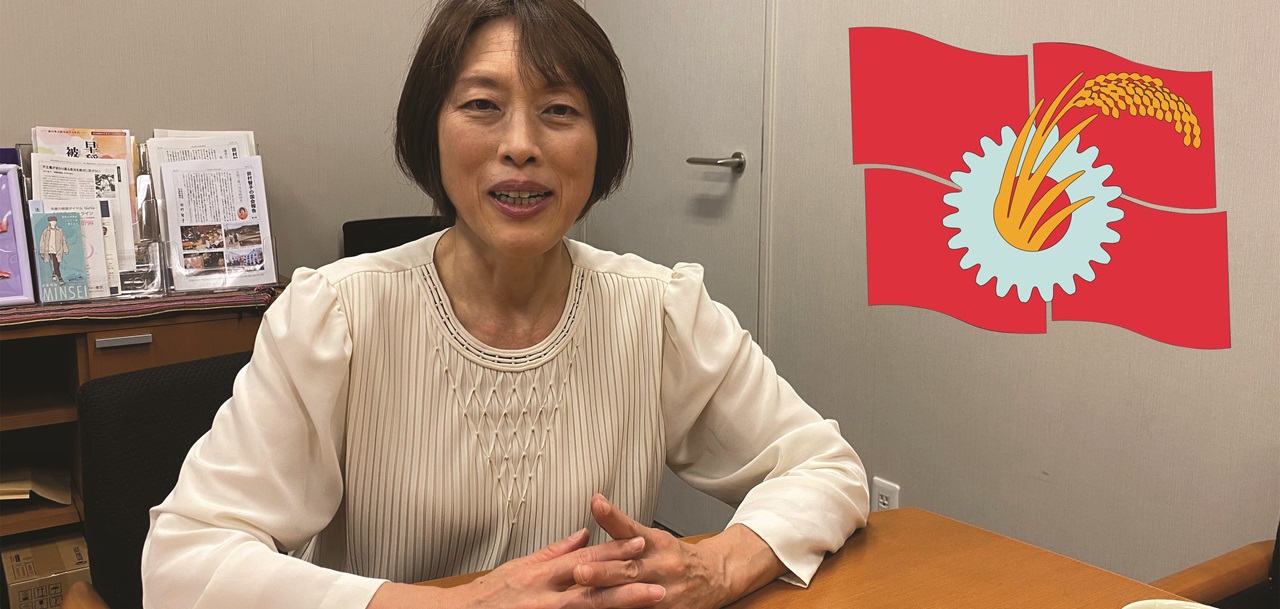
TOKYO—The Japanese Communist Party made history recently by electing its first woman party leader. Tomoko Tamura was appointed as the new Chair of the JCP Executive Committee by delegates to the party’s 29th Congress in January. She succeeds longtime JCP leader Kazuo Shii, who will now chair the Central Committee.
In traditionally male-dominated Japanese society, the Communists’ election of a strong woman leader is intended to send a signal to voters that their party is a forward-looking one determined to bring about social change.
At age 58, Tamura’s elevation to the top leadership post from her previous position as head of the party’s Policy Commission also marks a generational change for the JCP.
Up from the grassroots
Tamura was born in the city of Nagano and got her start as an activist while a student at Waseda University, becoming a leader in the movement against tuition hikes. As a young adult, she joined the JCP and served as an aide to Communist lawmakers.

She was a candidate for the Diet (Japan’s parliament) on four occasions before successfully winning a seat under Japan’s proportional representation system for the first time in 2010. Voters returned her to parliament at the 2016 and 2022 national elections.
Though she has long been a recognized leader among JCP members, Tamura became known to the broader Japanese public in November 2019 after she blew the lid off then-Prime Minister Shinzo Abe’s use of a political slush fund to buy off voters and reward supporters.
Over the course of several years, Abe had improperly used more than 30 million yen ($200,000 USD) redirected from political funds to pay for dinners and other expenses for his backers to attend so-called “Cherry Blossom Viewing Parties,” at which supporters could dine with the prime minister at a subsidized rate while supposedly looking at Japan’s famed cherry blossoms.
Tamura was the first to raise questions about the affair in the Diet. Her scrutiny of Abe’s practices led to a massive legal inquiry and sparked what became known as the “Cherry Blossom Scandal.”
Even before the scandal, though, she had already earned a reputation as a thorn in the side of the ruling party. In 2014, when Abe made a few token female appointments to his cabinet, Tamura dismissed the move as “a performance for public consumption.”
Women lawmakers from Abe’s Liberal Democratic Party, Tamura said, were only elevated to higher office by their leaders if they stuck to traditional conservative gender roles. She pointed out that one of the women Abe made a minister had even voted against a gender equality bill.
“Those newly-appointed female politicians are not those who have been engaged in promoting gender equality in Japanese society or the empowerment of women,” Tamura said at the time. “Instead, it is merely window-dressing.”
A forward-looking party of the people
As Tamura assumes the post of JCP chair, the party’s Central Committee has its highest level of women leaders ever, 68 out of 215. Further, women made up 45% of the delegates to the 29th Congress—up ten percentage points from the previous congress and a clear marker that the party’s efforts to improve its internal gender imbalance are working.
By comparison, the LDP bragged in 2021 that it was breaking new ground when it invited five women lawmakers to attend its all-male board meetings—as long as they didn’t speak. They were allowed to observe and submit comments afterwards.
The congress, held in Shizuoka’s Atami City, approved a resolution calling on members to build a bigger and stronger JCP and to launch a “national movement” aimed at ending the corrupt politics of LDP rule.
Communists made the advancement of workers—both organized and unorganized—a central feature of their discussions. The fact that the government is allowing corporate conglomerates to stockpile vast sums of profits in bloated savings accounts while wage growth remains non-existent is a primary complaint of the JCP.
The party promised to step up its work with labor unions and other civic organizations to raise the national minimum wage to 1,500 yen ($10 USD) per hour. Currently, there is no national minimum wage, and the highest regulated rate is to be found in Tokyo, which amounts to just 1,130 yen ($7.61 USD).
Recalling the deadly Fukushima nuclear disaster of 2011 and subsequent earthquakes and tsunamis that threatened power plants, the outgoing Central Committee said the need for a nuclear-free Japan is clearer than ever. And that need highlights, the party said, how far behind Japan is when it comes to planning for a post-fossil fuel future. The LDP has made few moves to leave either nuclear or coal behind.
Turning to internal matters of the JCP itself, discussions at the congress were optimistic about the future but also measured in terms of what has been achieved. In the last four years, over 16,000 new people have joined the JCP, but accounting for lost members, the ranks actually declined by 20,000. The party’s newspaper, Shimbun Akahata (Red Flag), has a combined print and digital readership of 850,000, but that is down from one million four years ago.
In the Central Committee’s report to the congress, which Tamura delivered, it was noted that while there has been some recent growth, both membership and press readership continue to be in a long-term decline overall. The gains that have been made are more than offset by the losses, meaning the net trend is still negative.
That is why, Tamura said, “Party building has become an increasingly urgent and vital task for our party and for Japan’s present and future.” In response, congress delegates set a goal of growing the party to 350,000 members by 2028 and raising the press subscriber base to 1.3 million. These are huge targets which won’t be easy to achieve, but Tamura expressed confidence that the party branches around the country would respond.
Like Japanese society generally, the party is greying. That’s why doubling the number of young people in their 30s to 50s was highlighted as a particularly important task in Tamura’s speech.
This cohort will make up the next generation of JCP leadership, but there are not enough of them in the party ranks. Many veteran leaders are receding in terms of their level of activity, and activists of the student generation are not yet in a position to take on roles that require extensive political and organizational experience.
To address the “missing generation” gap, all party districts and branches were instructed to formulate a “5-Year Plan for Generational Succession” and to work overtime to identify and develop cadres for training and further growth.
Aside from the impressive organizational challenges the congress tackled, it was also notable for the number of out LGBTQ people that participated, setting a high bar for other parties in socially conservative Japan.
The JCP has been one of the few political parties to vocally back LGBTQ rights in the country; Communist lawmakers have been working to win passage of marriage equality and anti-discrimination laws in parliament. And in recent years, JCP leaders have become regular fixtures at Pride events.
The congress was welcomed by the local Atami City mayor, and congratulatory messages were sent by trade unions, municipal leaders, governors, and other organizations and public figures across Japan.
Fraternal greetings were received from several overseas parties, among them the Communist Parties of the USA, Britain, Cuba, Chile, France, Vietnam, Venezuela, Portugal, and India (Marxist).
Support was also offered by Spain’s United Left Party, the Danish Red-Green Alliance, Die Linke in Germany, the Party of the European Left, La France Insoumise, the Workers Party of Brazil, the Lao People’s Revolutionary Party, the Rosa Luxemburg Foundation, and many more.
A fighting leader
As for the new party leader, Tamura didn’t wait long to use her new position as a tribune for the Japanese people. At the latest meeting of the Diet, she rose to speak and encouraged a united opposition to LDP rule.

“Let us…address public anger and give hope for a change in government,” Tamura declared at the Jan. 26 session. She said unity was needed to support victims of the major New Year’s Day earthquake that hit Noto Peninsula, and she pointed out that the government was doing far too little to help.
Ongoing LDP financial misdeeds were also a theme of her speech, as she pressed for a full inquiry to find the truth behind the latest unregistered fundraising income scandal. “A drastic political reform to root out money-power corruption” of the LDP is needed, Tamura said.
The right-wing LDP has ruled the country almost continuously since 1955, secretly funded and sustained in power for years with the help of the United States and the CIA. Top LDP leaders were often agents or affiliates of the CIA during the Cold War era, and millions of dollars were spent by the U.S. to infiltrate and sabotage left-wing parties like the Japan Socialist Party and the JCP.
Though the Cold War is long over, the ruling political elite’s addiction to dark money that started in those years remains as strong as ever.
Turning to the failures of capitalism and the government’s inability to turn around Japan’s decades-long economic recession, Tamura criticized Prime Minister Kishida Fumio for “continuing the same policies that led to the 30 lost years.”
Japan’s economy went bust in the early 1990s and has never really recovered, with growth stagnant since then and only worsened by the COVID-19 pandemic.
It was a topic that played a starring role in Tamura’s report to the JCP Congress, as well, in which she criticized government decisions to cut taxes on corporations while raising them on working people.
And picking apart the government’s 2024 budget, Tamura slammed the 8 trillion yen ($54 billion) that Kishida and the LDP have designated for military spending, including the mass production of long-range missiles.
“Prime Minister Kishida’s attempt to turn Japan into a war-fighting nation has become clear,” Tamura said. She pledged that Japanese Communists would join with other opposition parties and fight to build a united front movement to “create an East Asia free of the fear of war.”
It was an echo of her congress report, where she declared that Japan must not be “a warring nation that does America’s bidding.”
We hope you appreciated this article. At People’s World, we believe news and information should be free and accessible to all, but we need your help. Our journalism is free of corporate influence and paywalls because we are totally reader-supported. Only you, our readers and supporters, make this possible. If you enjoy reading People’s World and the stories we bring you, please support our work by donating or becoming a monthly sustainer today. Thank you!












Comments